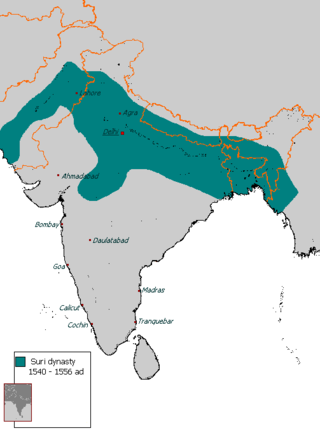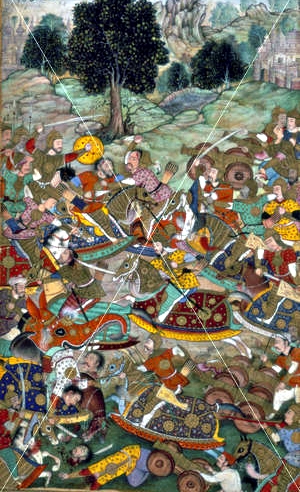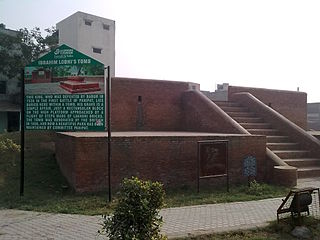
Babur, born Zahīr ud-Dīn Muhammad, was the founder of the Mughal Empire in the Indian subcontinent. He was a descendant of Timur and Genghis Khan through his father and mother respectively. He was also given the posthumous name of Firdaws Makani.

The first Battle of Panipat, on 20 April 1526, was fought between the invading forces of Babur and the Lodi dynasty. It took place in North India and marked the beginning of the Mughal Empire and the end of the Delhi Sultanate. This was one of the earliest battles involving gunpowder firearms and field artillery in the Indian subcontinent which were introduced by Mughals in this battle.

Ibrahim Khan Lodi (or Lodhi) (Pashto: ابراهیم خان لودي), (1480 – 21 April 1526) was the last Sultan of the Delhi Sultanate, who became Sultan in 1517 after the death of his father Sikandar Khan Lodi. He was the last ruler of the Lodi dynasty, reigning for nine years until 1526, when he was defeated and killed at the Battle of Panipat by Babur's invading army, giving way to the emergence of the Mughal Empire in India.

Sangram Singh I, popularly known as Rana Sanga or Maharana Sanga, was an Indian ruler from the Sisodia dynasty. He ruled Mewar, the traditional territory of Guhilas (Sisodias) in present-day north-western India. However, through his capable rule his kingdom turned into one of the greatest powers of Northern India in early sixteenth century. He controlled parts of present-day Rajasthan, Gujarat, Madhya Pradesh and Uttar Pradesh with the capital being Chittor. His reign was admired by several of his contemporaries, including Babur, who described him as the "greatest Indian King" of that time along with Krishnadevaraya of South India. The Mughal historian Al-Badayuni called Sanga the bravest of all Rajputs along with Prithviraj Chauhan. Rana Sanga was the last independent Hindu king of Northern India to control a significant territory before the Mughal Era. In some contemporary texts, he is described as the Hindu Emperor (Hindupati) of Northern India.

Hisar also known as Hissar is a city, municipal corporation and administrative headquarters of Hisar district of Hisar division in the state of Haryana in northwestern India. It is located 161.2 km (100.16 mi) to the west of New Delhi, India's capital, and has been identified as a counter-magnet city for the National Capital Region to develop as an alternative centre of growth to Delhi.

Panipat is a historic city in Haryana, India. It is 95 km north of Delhi and 169 km south of Chandigarh on NH-1. The three major battles fought in 1526, 1556 and 1761 took place near the city. The city is famous in India as the "City of Weavers" and "Textile City". It is also known as the "cast-off capital" due to being "the global centre for recycling textiles". Panipat is included in the list of Critically Polluted Industrial area in India. The Comprehensive Environment Pollution Index (CEPI) of the city is 71.91 as against 88.50 of Ankaleshwar (Gujarat). The fatal field of Panipat is the site of three battles that changed the course of India's history, resulting in the creation and confirmation of the Mughal Empire, as well as the decisive defeat of the Maratha Confederacy in North India.

The Lodi dynasty was an Afghan, or Turco-Afghan, dynasty that ruled the Delhi Sultanate from 1451 to 1526. It was the fifth and final dynasty of the Delhi Sultanate, and was founded by Bahlul Khan Lodi when he replaced the Sayyid dynasty.

The Sur Empire was an Afghan dynasty which ruled a large territory in the northern part of the Indian subcontinent for nearly 16 years, between 1540 and 1556, with Sasaram, in modern-day Bihar, serving as its capital.

The Battle of Khanwa was fought at Khanwa on March 16, 1527. It was fought between the invading Timurid forces of Babur and the Rajput confederacy led by Rana Sanga for suprermacy of Northern India. The battle was a major event in Medieval Indian history although Timurids won at Panipat but at the time, the sultanate at Delhi was a spent force that was long crumbling. To the contrary Mewar kingdom, under the able rule of Rana Sanga, had turned into one of the strongest powers of northern India. Therefore the battle was among the most decisive battles in the Mughal conquest of northern India.

Delhi has a long history, and has been an important political centre of India as the capital of several empires. Earliest coverage of Delhi's history is in the onset of the Tomar's kingdom in the 8th century. It is considered to be a city built, destroyed and rebuilt several times, as outsiders who successfully invaded the Indian Subcontinent would ransack the existing capital city in Delhi, and those who came to conquer and stay would be so impressed by the city's strategic location as to make it their capital and rebuild it in their own way.
The Battle of Ghaghra, fought in 1529, was a great battle for the conquest of India by the Mughal Empire. It followed the first Battle of Panipat in 1526 and the Battle of Khanwa in 1527. The forces of Mughal Emperor Babur of the emerging Mughal Empire were joined by Indian allies in battle against the Eastern Afghan Confederates under Sultan Mahmud Lodi and Sultanate of Bengal under Sultan Nusrat Shah.

Daulat Khan Lodi was the governor of Lahore during the reign of Ibrahim Lodi, the last ruler of the Lodi dynasty. Due to disaffection with Ibrahim, Daulat invited Babur to invade the kingdom. He was initially governor of the Jalandhar Doab before being promoted with the governorship of the entire Punjab. He was the son of Tatar Khan, the previous Nizam of Punjab, who had asserted his independence from Lodi dynasty under Behlol Lodi, father of Sikander Lodi. Daulat Khan was loyal to the dynasty but betrayed Ibrahim due to his rigid, proud and suspicious nature.
Events from the year 1526 in India.
The Battle of Tughlaqabad was a notable battle fought on 7 October 1556 between a Hindu king Hem Chandra Vikramaditya, also known as Hemu and the forces of the Mughal emperor Akbar led by Tardi Beg Khan at Tughlaqabad near Delhi. The battle ended in a 'victory of Hem Chandra' who took possession of Delhi and claimed royal status, assuming the title of Raja Vikramaditya. Following his failure, Tardi Beg was executed by Akbar's regent, Bairam Khan. The two armies would meet again at Panipat a month later with opposite results.
The early Muslim period refers to the start of Muslim rule in the history of Lahore. Few references to Lahore remain from before its capture by Sultan Mahmud of Ghazni in the eleventh century. The sultan took Lahore after a long siege and battle in which the city was torched and depopulated. In 1021, Sultan Mahmud appointed Malik Ayaz to the throne and made Lahore the capital of the Ghaznavid Empire. As the first Muslim governor of Lahore, Ayaz rebuilt and repopulated the city. He added many important features, such as city gates and a masonry fort, built in 1037–1040 on the ruins of the previous one, which had been demolished in the fighting. The present Lahore Fort stands on the same location. Under Ayaz's rule, the city became a cultural and academic center, renowned for poetry. The tomb of Malik Ayaz can still be seen in the Rang Mahal commercial area of town.
Mughal artillery included a variety of cannons, rockets, and mines employed by the Mughal Empire. This gunpowder technology played an important role in the formation and expansion of the empire.

The Kabuli Bagh Mosque is a mosque in Panipat, Haryana, India which was built in 1527 by the emperor Babur to mark his victory over Sultan Ibrahim Lodhi at the first Battle of Panipat in 1526. The mosque is named after Kabuli Begum, Babur's wife.

The Tomb of Ibrahim Lodi in Panipat is the tomb of Ibrahim Lodi, Sultan of the Lodi dynasty.
The Tomaras of Gwalior were a Rajput dynasty who ruled the Gwalior Fort and its surrounding region in central India during 14th–16th centuries. They are known for their patronage to the cultural activities in Gwalior.












